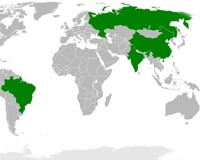| . |  |
. |
Yekaterinburg, Russia (AFP) June 16, 2009 Leaders from emerging giants Brazil, Russia, India and China were Tuesday to meet for the first summit of their informal BRIC grouping in a show of unity in the face of a sharp global slowdown. The idea for the BRIC (Brazil, Russia, India, China) grouping was spawned after research by a US investment bank suggested the four economies were developing at such pace they could be amongst the world's strongest by 2050. Presidents Dmitry Medvedev of Russia, Hu Jintao of China, Luiz Inacio Lula da Silva of Brazil and Indian Prime Minister Manmohan Singh will meet in Yekaterinburg, a city some 1,420 kilometers (880 miles) east of Moscow in the Ural Mountains. It remains to be seen whether the quartet will agree to create a more official format for the grouping, an idea that was never anticipated when the original research was undertaken by Goldman Sachs of the United States. Russia has taken a leading role in promoting BRIC, evidently happy with the idea that it remains an economic force despite seeing its high growth rates of recent years savaged by the worst global economic crisis since the 1930s. Analysts say that despite -- or perhaps because of -- the economic crisis, BRIC nations are displaying a growing willingness to coordinate their efforts as they seek to counter US global domination through the ubiquitous dollar and forge a bigger role for themselves. The BRIC states are expected to be major buyers of the very first bonds that the International Monetary Fund (IMF) is working to issue, in line with commitments by developed and developing economies to provide 1.1 trillion dollars to the IMF and other global bodies to help the poor through the crisis. China has said it is considering buying up to 50 billion dollars' worth of the new financial instrument, while Russia and Brazil could buy up to 10 billion dollars each. Both Russia and China have in recent months come out in favour of revamping global financial structures, saying there is a need for a new supra-national currency besides the dollar to prevent a repeat of the global economic crisis. Moscow in particular has sharply criticised the dollar's role as the dominant global reserve currency. "The rising BRIC investment in IMF bonds paves the way for closer and greater involvement and influence by BRICs -- or putting their money down where their BRIC ambitions are in the IMF and World Bank," said Jan Randolph, head of sovereign risk analysis at IHS Global Insight. But analysts are sceptical that the BRICs can create a new reserve currency or act as a tight economic or financial entity any time soon, even as they acknowledge the importance of the group's first gathering. Rory MacFarquhar, a Moscow-based economist at Goldman Sachs, said the significance of the summit would be political rather than economic. "There's considerable interest -- you could say from all (the BRIC) countries but Russia in particular -- in creating an alternative" to established international organisations, he said. He added that Tuesday's high-profile meeting would be part of the Kremlin's "crusading against anything it considers unipolarity" -- another way of describing US domination. Of the major economies, powerhouse China is seen as having the best shot at eclipsing the United States as the world's largest market. The BRIC leaders first met informally on the sidelines of a Group of Eight major economies summit in Toyako, Japan, last year. Share This Article With Planet Earth
Related Links The Economy
 Emerging big four economies flaunt power at summit
Emerging big four economies flaunt power at summitMoscow (AFP) June 14, 2009 Brazil, Russia, India and China flaunt their unity against more established powers this week as the four emerging economic giants hold the first summit of their grouping, known as BRIC. But while they will express determination to act together during the current economic crisis and beyond, they are years away from being a counterbalance to established global institutions, analysts say. ... read more |
|
| The content herein, unless otherwise known to be public domain, are Copyright 1995-2009 - SpaceDaily. AFP and UPI Wire Stories are copyright Agence France-Presse and United Press International. ESA Portal Reports are copyright European Space Agency. All NASA sourced material is public domain. Additional copyrights may apply in whole or part to other bona fide parties. Advertising does not imply endorsement,agreement or approval of any opinions, statements or information provided by SpaceDaily on any Web page published or hosted by SpaceDaily. Privacy Statement |